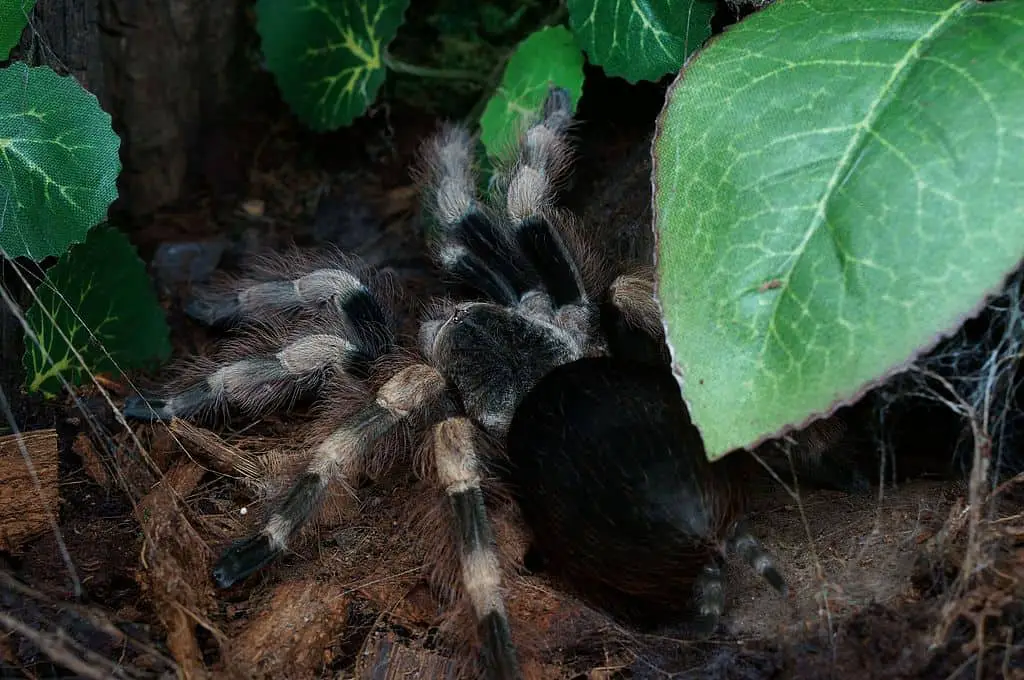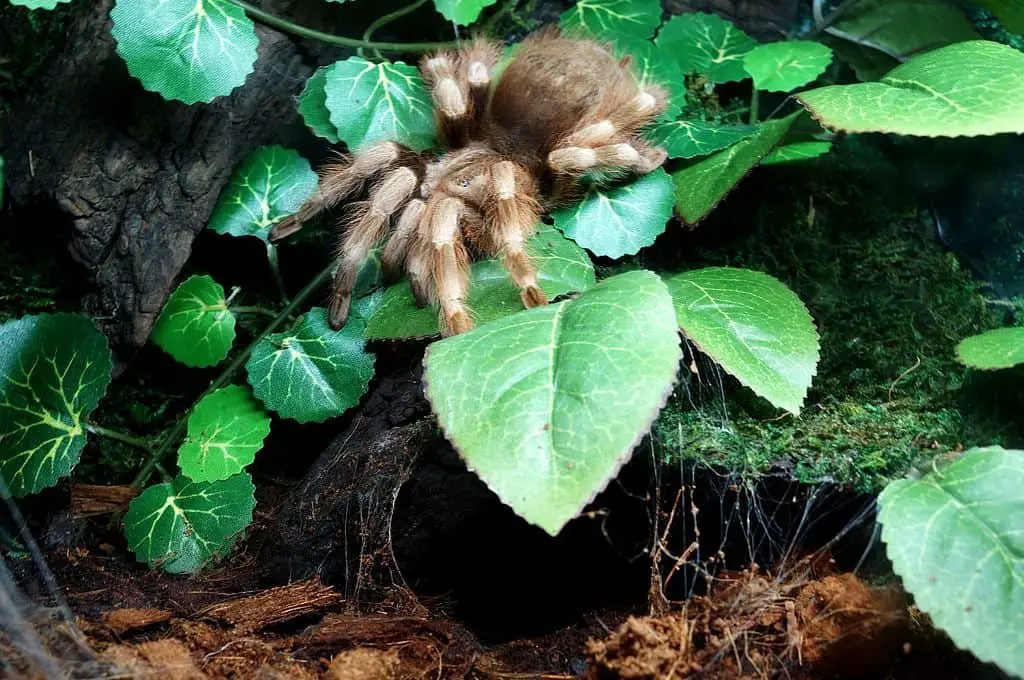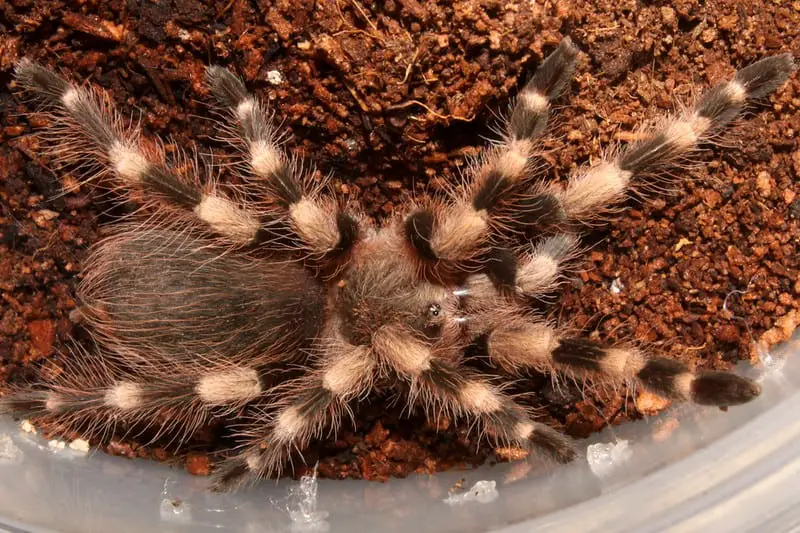The Brazilian Black and White is a New World species from Brazil with reported sightings in Paraguay. As her name suggests, she has a mesmerizing black and white pattern around her body.
She’s also known for being emotionally unpredictable since her behavior varies by the specimen. However, most owners will describe their particular pet as nervous and skittish, so that’s what you should generally expect from her. Nevertheless, they’re also quite docile and do not have a tendency to behave very defensively.
If you’re interested in getting a Brazilian Black and White Tarantula for your collection, we’ll disclose all the details you need to know about them in this article.

Brazilian Black and White Tarantula Care Sheet
| Species Name | Nhandu coloratovillosus |
| Family Name | Theraphosidae |
| Common Names | Brazilian Black and White Tarantula |
| Category | New World |
| Type | Terrestrial |
| Native Location | Brazil, Paraguay |
| Body length | 2 inches (5 cm) |
| Leg Span | 5.5 to 6 inches (14-15 cm) |
| Growth Speed | Medium – Fast |
| Urticating Hairs | Yes, type 1 |
| Social | Solitary |
| Diet | Insects: primarily crickets and roaches |
| Temperature | 77 to 82 degrees °F |
| Humidity | 70 to 80% |
| Lifespan | Female: 13 to 15 years / Male: 3 to 4 years |
| Experience required | Beginner |
| Minimum tank size | 5 gallons. Horizontal space > Vertical space |
Brazilian Black and White Tarantula Overview
The Chandu coloratovillosus is better known as the Brazilian Black and White Tarantula or The Bombardier Tarantula.
It is a terrestrial tarantula and opportunist burrower, which means she tends to take residence in pre-existing burrows, sometimes from other species.
The Brazilian Black and White Tarantula uses urticating setae from her abdomen to attack aggressors when frightened or threatened, just like most other New World species.
Notorious for her capricious behavior, she’s like royalty who needs to be treated with care. Besides that, it’s uncommon for her to exhibit threat postures or bite, so she’s quite well suited for first-timers.
Appearance and Variants

The Brazilian Black and White Tarantula, as the name suggests, has a beautiful black and white stripe pattern on all legs; in addition, her abdomen is covered by sparkling reddish setae.
This beautiful tarantula has a dark-grey tone with slight hues of white in her cephalothorax. Some specimens have dark brown and white stripe patterns in their initial stages, changing into the previously mentioned signature pattern as they molt and age.
They display sexual dimorphism, so it’s relatively easy to tell males apart from females. Males are smaller and slender while showing a darker tone instead of their female counterpart’s white parts.
Females are bigger and with brighter colors. Their more eye-catching coloration often turns them into the main focus of a photo shoot.
As is the case with many tarantulas, their colors will be more bright and more vibrant right after a molt.
Price
The Brazilian Black and White Tarantula’s market value depends on their development stage and whether you purchase a male or female, as is the case with most tarantula species.
Spiderlings of this species can be bought for as little as $20. Juveniles will cost about $28, so they’re not much more expensive than spiderlings.
Unsexed and male adults can be found at around $40 to $60 in some cases.
And finally, due to their size, brighter colors, and longevity, females can be bought for $80 to $120.
Prices do depend highly on availability, and since these spiders are not the most popular in the hobby, they can sometimes be difficult to find which can drive their prices up.
Behavior and Temperament
The Brazilian Black and White Tarantula is an opportunistic burrower. She leans towards staying secluded inside a burrow; however, she has the habit of going out from time to time, traveling around the place a little bit, and then getting back inside.
Therefore, even though she’s rather shy, you’ll still be lucky enough to see her every once in a while.
Now, not every member of this species will behave this way. They’re described as erratic because some specimens are semi-aggressive or skittish even though most are peaceful and shy.
There are even reports of Brazilian Black and Whites that oscillate between these two behavior patterns from one moment to another, typically after a molt.
This tarantula can be frightened at the beginning of a rehousing operation, switching to a threat posture, then turning peaceful once again. She’ll then stay like this for a while before repeating the cycle again and again.
Besides all of this, although she may look like an accident waiting to happen, there are no reports of her biting humans.
Of course, they do have fangs, and thus they are capable of biting humans if they have no other choice, but it’s not something that tends to happen if you do not push them.
They do have venom, but as is the case with most New World species, their venom is very mild.
Her peaceful demeanor dominates her, so she usually freezes or hides before any actual confrontation.
However, she has urticating hair strong enough to dissuade large mammals, so you should always be careful around her.
Caring for a Brazilian Black and White Tarantula

Temperature and Humidity
Brazilian Black and White Tarantulas are from Brazil, where they’re used to high temperatures all year round with rain periods that rarely stop.
Temperatures are around 77ªF all year, so aim for the temperature in their enclosure to be around 77 F to 82 F, with 70% to 80% humidity for them to be comfortable.
Substrate
The Brazilian Black and White Tarantula needs a fossorial setup, so there should be enough substrate for burrowing. Two to three inches are good in the earlier stages when they’re still small.
As they grow and molt, they can be rehoused into a bigger tank with space for four inches of substrate, which is perfect for adults.
A soft and water-retaining substrate will do wonders for this spider, so mixtures containing peat moss and coconut fibers are a great fit for this tarantula.
Tank
The Brazilian Black and White Tarantula needs an ideal tank configuration for terrestrial spiders. It should be wider and longer than tall, with enough room to enable them to dig down.
Spiderlings can be comfortable in a 0.5-gallon enclosure.
Juveniles can be left in slightly larger enclosures like a one-gallon tank, making sure there’s at least three to four inches of substrate to guarantee her digging.
Once she reaches adulthood, a five-gallon tank is your best choice for her.
Make sure to provide them with a hide. A piece of cork bark is good, but you can also use half of a coconut shell or even an upside-down plant pot with a hole in it.
Once again, make sure the tank isn’t tall enough that your Brazilian Black and White would be at risk of falling and taking harm; terrestrial spiders are vulnerable to falls, which can sometimes rupture their abdomen and be lethal to them.
Watering
The Brazilian Black and White Tarantula needs moist soil to be comfortable, so spray the substrate once a week.
As for the water dish, It can be super-glued close to the burrow.
The times where these tarantulas actually drink are scarce, so don’t worry if you see her bowl mostly full. Nevertheless, you should still refill it on occasion to keep the water fresh.
Slings that are too small to drink from a bowl will drink droplets that are found around the enclosure. To provide them with these droplets you can spray some water on the glass on the inside of the enclosure or drop some water down the walls.
Social
The Brazilian Black and White tarantula is not a social species and they’re not suitable for communal housing. Putting more than one of these spiders has a very high chance of going wrong and ending with cannibalism.
Make sure that you always house them in a solitary enclosure.
Diet and Feeding
The Brazilian Black and White Tarantula has an appetite that varies between specimens, though they typically eat well.
Feeding them twice a week should be enough for spiderlings. They can eat pre-killed, sliced-up mealworms, cricket legs, or a flightless fruit fly at this stage of their life.
Juveniles enjoy having a small to medium cricket every week, but a medium roach will often be a welcome variation.
Adults should be fed five to seven large crickets every two weeks. Keep in mind that if you see your tarantula’s abdomen grow too plump or turn flat, you should adapt her diet by either reducing or increasing portions accordingly.
Brazilian Black and White Tarantula Facts
- The Nhandu coloratovillosus shares the common name “Brazilian Black and White” with The Acanthoscurria brocklehursti.
- Even though the common name is Brazilian Black and White Tarantula, the species’ scientific name “coloratovillosus” actually refers to the unusual red hair over her body.
- The name “Bombardier Tarantula” most likely refers to its strong and irritating urticating setae.
Final words
The Brazilian Black and White Tarantula is a beautiful and rewarding spider full of surprises and oddities. Their behavior varies quite a bit between individuals. Nevertheless, they’re often relatively docile, which makes them an okay starter-spider.
However, even for more experienced keepers, they can be an interesting addition due to their striking color and unique behavior.
- How Long Do American Eskimo Dogs Live? Important Factors and Care Tips - September 29, 2023
- Do American Bulldogs Need Grooming? Essential Tips and Care Guidelines - September 29, 2023
- Do Bengal Cats Enjoy Playing? Essential Tips for Keeping Them Active - September 29, 2023